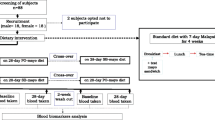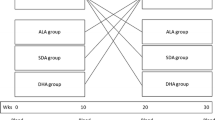Abstract
A plant source of omega-3 fatty acid (FA) that can raise tissue eicosapentaenoic acid (EPA) and/or docosahexaenoic acid (DHA) is needed. A soybean oil (SBO) containing approximately 20% stearidonic acid [SDA; the delta-6 desaturase product of alpha-linolenic acid (ALA)] derived from genetically modified soybeans is under development. This study compared the effects of EPA to SDA-SBO on erythrocyte EPA + DHA levels (the omega-3 index). Overweight healthy volunteers (n = 45) were randomized to SDA-SBO (24 ml/day providing ~3.7 g SDA) or to regular SBO (control group) without or with EPA ethyl esters (~1 g/day) for 16 weeks. Serum lipids, blood pressure, heart rate, platelet function and safety laboratory tests were measured along with the omega-3 index. A per-protocol analysis was conducted on 33 subjects (11 per group). Compared to baseline, average omega-3 index levels increased 19.5% in the SDA group and 25.4% in the EPA group (p < 0.05 for both, vs. control). DHA did not change in any group. Relative to EPA, SDA increased RBC EPA with about 17% efficiency. No other clinical endpoints were affected by SDA or EPA treatment (vs. control). In conclusion, SDA-enriched SBO significantly raised the omega-3 index. Since EPA supplementation has been shown to raise the omega-3 index and to lower risk for cardiac events, SDA-SBO may be a viable plant-based alternative for providing meaningful intakes of cardioprotective omega-3 FAs.
Similar content being viewed by others
References
Wang C, Harris WS, Chung M et al (2006) n-3 fatty acids from fish or fish-oil supplements, but not alpha-linolenic acid, benefit cardiovascular disease outcomes in primary- and secondary-prevention studies: a systematic review. Am J Clin Nutr 84:5–17
Yokoyama M, Origasa H, Matsuzaki M et al (2007) Effects of eicosapentaenoic acid on major coronary events in hypercholesterolaemic patients (JELIS): a randomised open-label, blinded endpoint analysis. Lancet 369:1090–1098
Kris-Etherton PM, Taylor DS, Yu-Poth S et al (2000) Polyunsaturated fatty acids in the food chain in the United States. Am J Clin Nutr 71:179S–188S
Harris WS, von Schacky C (2004) The omega-3 index: a new risk factor for death from coronary heart disease? Prev Med 39:212–220
Harris WS, Sands SA, Windsor SL et al (2004) Omega-3 fatty acids in cardiac biopsies from heart transplant patients: correlation with erythrocytes and response to supplementation. Circulation 110:1645–1649
Metcalf RG, James MJ, Gibson RA et al (2007) Effects of fish-oil supplementation on myocardial fatty acids in humans. Am J Clin Nutr 85:1222–1228
Harris WS (2007) Omega-3 fatty acids and cardiovascular disease: a case for omega-3 index as a new risk factor. Pharmacol Res 55:217–223
Kris-Etherton PM, Harris WS, Appel LJ (2002) Fish consumption, fish oil, omega-3 fatty acids, and cardiovascular disease. Circulation 106:2747–2757
Gebauer SK, Psota TL, Harris WS, Kris-Etherton PM (2006) n-3 fatty acid dietary recommendations and food sources to achieve essentiality and cardiovascular benefits. Am J Clin Nutr 83:1526S–1535S
Worm B, Barbier EB, Beaumont N et al (2006) Impacts of biodiversity loss on ocean ecosystem services. Science 314:787–790
Brenna JT (2002) Efficiency of conversion of alpha-linolenic acid to long chain n-3 fatty acids in man. Curr Opin Clin Nutr Metab Care 5:127–132
Plourde M, Cunnane SC (2007) Extremely limited synthesis of long chain polyunsaturates in adults: implications for their essentiality and use as supplements. Appl Physiol Nutr Metab 32:619–634
Yamazaki K, Fujikawa M, Hamazaki T, Yano S, Shono T (1992) Comparison of the conversion rates of alpha-linolenic acid (18:3(n-3)) and stearidonic acid (18:4(n-3)) to longer polyunsaturated fatty acids in rats. Biochim Biophys Acta 1123:18–26
Ursin VM (2003) Modification of plant lipids for human health: development of functional land-based omega-3 fatty acids. J Nutr 133:4271–4274
Riess H, Braun G, Brehm G, Hiller E (1986) Critical evaluation of platelet aggregation in whole human blood. Am J Clin Pathol 85:50–56
James MJ, Ursin VM, Cleland LG (2003) Metabolism of stearidonic acid in human subjects: comparison with the metabolism of other n-3 fatty acids. Am J Clin Nutr 77:1140–1145
Pawlosky RJ, Hibbeln JR, Novotny JA, Salem NJ (2001) Physiological compartmental analysis of alpha-linolenic acid metabolism in adult humans. J Lipid Res 42:1257–1265
Goyens PL, Spilker ME, Zock PL, Katan MB, Mensink RP (2006) Conversion of alpha-linolenic acid in humans is influenced by the absolute amounts of alpha-linolenic acid and linoleic acid in the diet, and not by their ratio. Am J Clin Nutr (in press)
Siscovick DS, Raghunathan TE, King I et al (1995) Dietary intake and cell membrane levels of long-chain n-3 polyunsaturated fatty acids and the risk of primary cardiac arrest. J Am Med Assoc 274:1363–1367
Albert CM, Campos H, Stampfer MJ et al (2002) Blood levels of long-chain n-3 fatty acids and the risk of sudden death. N Engl J Med 346:1113–1118
Harris WS, von Schacky C (2008) Omega-3 fatty acids, acute coronary syndrome and sudden death. Curr Hypertens Rep 2:161–166
Sands SA, Reid KJ, Windsor SL, Harris WS (2005) The impact of age, body mass index, and fish intake on the EPA and DHA content of human erythrocytes. Lipids 40:343–347
Albert CM, Oh K, Whang W et al (2005) Dietary alpha-linolenic acid intake and risk of sudden cardiac death and coronary heart disease. Circulation 112:3232–3238
Djousse L, Arnett DK, Carr JJ et al (2005) Dietary linolenic acid is inversely associated with calcified atherosclerotic plaque in the coronary arteries: the NHLBI family heart study. Circulation 111:2921–2926
Ascherio A, Rimm EB, Giovannucci EL, Spiegelman D, Stampfer M, Willett WC (1996) Dietary fat and risk of coronary heart disease in men: cohort follow up study in the United States. BMJ 313:84–90
Harris WS (2005) Alpha-linolenic acid—a gift from the land? Circulation 111:2872–2874
Whelan J, Rust C (2006) Innovative dietary sources of n-3 fatty acids. Annu Rev Nutr 26:75–103
Miles EA, Banerjee T, Dooper MM, M’Rabet L, Graus YM, Calder PC (2004) The influence of different combinations of gamma-linolenic acid, stearidonic acid and EPA on immune function in healthy young male subjects. Br J Nutr 91:893–903
Miles EA, Banerjee T, Calder PC (2004) The influence of different combinations of gamma-linolenic, stearidonic and eicosapentaenoic acids on the fatty acid composition of blood lipids and mononuclear cells in human volunteers. Prostaglandins Leukot Essent Fatty Acids 70:529–538
Surette ME, Edens M, Chilton FH, Tramposch KM (2004) Dietary echium oil increases plasma and neutrophil long-chain (n-3) fatty acids and lowers serum triacylglycerols in hypertriglyceridemic humans. J Nutr 134:1406–1411
Iso H, Kobayashi M, Ishihara J et al (2006) Intake of fish and n-3 fatty acids and risk of coronary heart disease among Japanese: the Japan public health center-based (JPHC) study cohort I. Circulation 113:195–202
Acknowledgments
The authors express their appreciation to Karla Reilly, RN, for study coordination and to Andrew Christianson and Brenda Collison–Schmidt for the RBC analyses. In addition, we wish to thank our research volunteers, without whom this study would not have been possible. This study was funded by Monsanto Company.
Author information
Authors and Affiliations
Corresponding author
Electronic supplementary material
Below is the link to the electronic supplementary material.
About this article
Cite this article
Harris, W.S., Lemke, S.L., Hansen, S.N. et al. Stearidonic Acid-Enriched Soybean Oil Increased the Omega-3 Index, an Emerging Cardiovascular Risk Marker. Lipids 43, 805–811 (2008). https://doi.org/10.1007/s11745-008-3215-0
Received:
Accepted:
Published:
Issue Date:
DOI: https://doi.org/10.1007/s11745-008-3215-0




